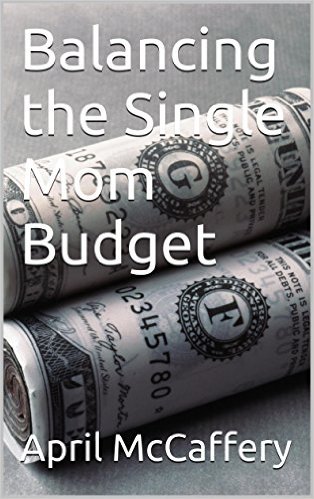Occasionally Logix will invite guests to post on financial topics, and we are pleased to present this article from April McCaffery, author ofthe book Balancing the Single Mom Budget. She also runs the It’s All About Balance blog.
Opinions expressed by our guest bloggers do not necessarily represent the views or advice of Logix federal Credit Union.
________________________________________

It’s that time of year where people make resolutions to start the New Year right, and taking stock of your financial life is a great way to get started.
Do you know how much you owe?
- Take a minute to look at the current outstanding balances left on your mortgage, student loan(s), credit card debt, car payment (not the monthly, but the total outstanding balance), and any other outstanding loans. While it can be overwhelming if it’s a large number, it can also be great motivation to make some changes.
Look at your monthly budget.
- Does it include what you just spent on Christmas presents? On birthday presents? What about your annual memberships and dues? And don’t forget about car maintenance. How about your kids’ extracurricular activities and back-to-school shopping?
It’s pretty common for monthly budgets to be missing these kinds of items, but the information is probably readily available by checking your banking monthly statements for the past year (including your credit card statements).
Once you get an idea of the total spending for these non-monthly expenses in 2015, divide that by 12 and make it a monthly expense in 2016. And add another item to your budget for stuff you missed or completely unexpected.
Now you’re ready for the biggie: Do not incur new debt. Period.
It took me a number of years to wrap my head around that. There were a few times when I would pay off my credit card debt in full… only to start adding to it again within a few months.
As a single mother of two daughters with one income (and a deadbeat ex), I just accepted this as normal – until I had enough.
I needed to get beyond paycheck-to-paycheck living. I needed to stop paying high interest rates. I needed to improve my credit score. The only way I could do any of that was to stop incurring new debt. I knew that what previously tripped me up were all those non-monthly expenses; most especially, car maintenance.
I was lucky that I didn’t have a car payment, but that meant I was driving an older car which required more frequent (and costly) trips to the auto shop. So I stopped trying to aggressively pay down credit card (while still making the minimum payments) to build up an emergency fund. Sure enough, the next time I had a $500-plus car repair, I was able to pay it in cash.
Even if your debt is sky high, it will never get smaller if you continue to add to it. So concentrate first on adding a little more to your checking or savings balance so that you can pay in cash for any non-monthly expense all year long.
A few clarifications
Keep it at a minimum
- If you just need to pay the minimum on your credit card debt for now, keep it at that level. When I first started, my minimum payment was close to $300. Sure enough, every month that went by without me adding to that debt, the minimum payment decreased, but I kept it at that $300 mark. So I’m not saying to just pay the minimum forever, but to continue paying that amount every month from now on, and that balance will slowly but surely decrease.
Be wise
- You may continue to accrue student loan debt while you’re in school. You may be saving for a down payment for a house. Not all debt is evil, of course, but you’ll need to plan for how you’ll pay these new debts off in the years to come.
- Be sure to shop around and check out discount re-sellers to avoid paying full price for textbooks. (Many can be rented on Amazon or through libraries.)
- Consider a used instead of new car and if you need to take on a car payment, don’t just look at the monthly amount. Instead, focus on the interest rate and minimizing the term of the loan.
- There really aren’t any exceptions, however, for incurring new credit card debt. That’s just always a bad financial decision.
Remember that your budget is not set in stone. Yes, things will come up and you may have to “borrow” some from groceries to cover buying supplies for your child’s school project. In the beginning, these moments will be stressful, but every time you can do it without incurring new debt, you will feel more financially confident.
If/when you come into a windfall (i.e., unexpected dollars like a bonus or tax refund), split it three ways: 1/3 toward your emergency savings, 1/3 toward your debt, and 1/3 toward something fun. You’ll be tempted to splurge it all, or sock it all away, but I have found the “all-or-nothing” approach to be unproductive. You should celebrate this unexpected new money, but you don’t have to get completely out of hand.
See what monthly payments you can decrease or eliminate. Are you paying for a gym membership you don’t use? Obtain at least three quotes to see if you’re paying too much for insurance. Don’t try to do it all at once, but every month, pick a different category to focus on decreasing or dropping. It took us awhile, but we cut the cable cord, switched cell phone providers, and I bring my lunch to work almost daily. This freed-up money can then go toward debt or savings, or both.
By implementing these changes, I have paid off my credit card debt entirely, and more than doubled my savings. I use credit cards for rewards, but it’s paid in full every month, and my credit score is now excellent. I have a positive net worth.
Even better, every year, my financial life gets better. None of it happened overnight, of course, but it all started with simply making the decision to not incur any new debt.
If you simply follow that one resolution to not incur new debt, without fail, your financial life will improve in 2016 and beyond.











